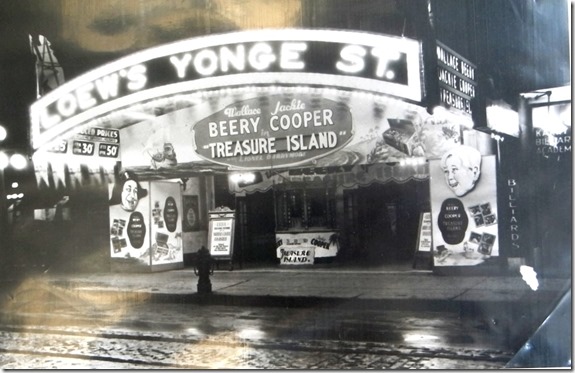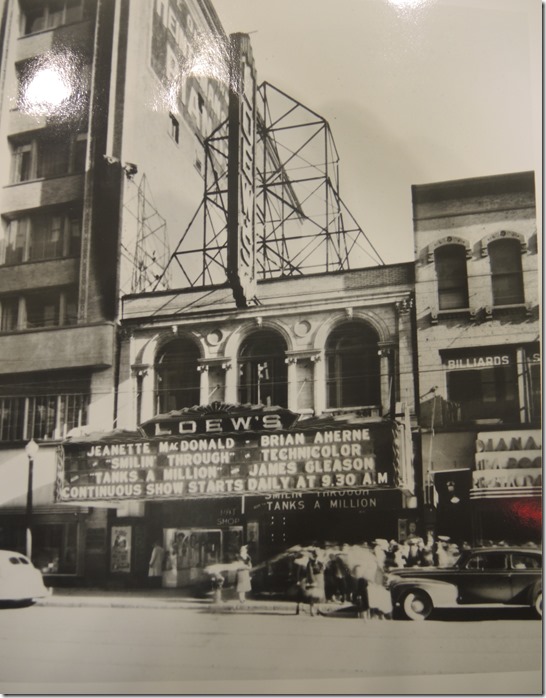The magnificent theatre complex on Yonge Street, a few doors north of Queen Street was erected in 1913. Though it was a project of considerable size and complexity, the construction was completed in only eight months. Designed by the architect Thomas W. Lamb, it was intended as the Canadian flagship theatre for the expanding chain of vaudeville and film theatres of Marcus Loew from New York City. For his new theatre, he purchased only a small amount of land facing Yonge Street, as real estate price on the city’s main thoroughfare were astronomical. The narrow strip that he bought was $600,000, and the concrete reinforced building cost him an additional $300,000. It contained two full-sized theatres, one located above the other. Less than a dozen of these “stacked” theatres were built in North America, and the one on Yonge Street is only one in Canada that remains today. Two survive in the United States.
The lower theatre was named “Loew’s Yonge Street Theatre.” It opened on December 15, 1913 and was the larger of the two theatres in the complex, seating 2149 patrons. For its inauguration, celebrities arrived from New York, including Marcus Loew, architect Thomas Lamb and Irving Berlin, who introduced a new song for the occasion. The vaudeville team of “Weber and Fields” was featured.
The narrow, elegant hallway that gave access to the theatre from the Yonge Street entrance was aligned west-east, and the auditorium within was aligned north-south, parallel with Victoria Street. This arrangement reduced the need for a large portion of the site to actually be on Yonge Street. The elongated entrance hallway gave access to the theatre, which was set back a distance from Yonge Street. The hallway also was useful in providing shelter for line-ups on rainy days or during the winter season. The hallway was decorated in the classical style, similar to a great European palace. It contained enormous panels covered with damask fabric, pilasters with ornate capitals, rich Edwardian colours and Victorian murals. Only the radiator caps and baseboards were real marble, the remainder being faux-marble moulded from plaster. Even today, patrons are impressed with the grand entrance hallway as they enter the theatre, which is now named the Elgin.
The ornate auditorium of the Loew’s Yonge Street Theatre (Elgin) was intended to add to the patrons’ pleasure of attending its performances, making the theatre’s splendour an integral part of the experience. It featured gilded plaster ornamentations, faux marble finishes and damask wall fabrics. The colour that predominated was gold, the ceiling also swathed in gold as well as being richly ornamented.
In 1913, tickets were ten cents and twenty-five cents. By comparison, a ticket at the Royal Alexandra Theatre in that year was two dollars. With the opening of Loew’s Yonge Street, with its increased prices, the nickelodeon became a thing of the past. Within two years, almost all the theatres throughout the city had raised their prices. A typical show at Loew’s consisted of eight to ten vaudeville acts, interspersed with a silent movie and a newsreel. The theatre was nicknamed “The Grind House,” as it “ground out” continuous shows that commenced daily at 11 a.m.
On December 19, 1929 Loew’s Yonge Street Theatre screened its first talking picture titled,“His First Glorious Night,” starring John Gilbert. The advertising for the film declared: “You’ve seen him make love, now hear him in his greatest romance.” The movie also starred Hedda Hopper, its director being Lionel Barrymore.
In 1939, “Gone With the Wind” and “The Wizard of Oz” had their Toronto premiers at the theatre. During the screening of “Gone With the Wind,” small coin-operated machines were installed on the backs of the seats. Patrons inserted ten cents, turned the knob, and candy dropped from the slot. They were mini-versions of the bubble-gum machines that became popular during the 1940s and 1950s.
In 1960, the theatre was renovated to accommodate “Cinerama,” which required three projectors. To be able to install the expansive curved screen, the opera boxes and the proscenium arch were removed. However, the theatre owners later changed their minds and Cinerama was never shown, but the damage to the interior of the auditorium had already been done. It was not repaired but covered over with curtains. When I was a teenager in the 1950s, I attended the theatre many times. In those days it was named Loew’s Downtown. Two of the most memorable films I saw there were “The “Student Prince” and “The Great Caruso,” both, featuring the voice of Mario Lanza.
In 1978, it was renamed the Elgin. However, by this year the theatre had deteriorated and was showing soft-porn movies.
The Winter Garden Theatre
The Winter Garden Theatre, which was seven storeys above “Loew’s Yonge Street Theatre,” seated 1410 theatre goers. It opened on February 16, 1913. It offered the same shows as the downstairs theatre, but all seats were reserved, at a cost of twenty-five or fifty cents. It featured only one performance per evening, which consisted of eight to ten vaudeville acts, interspersed with a silent movie and a newsreel. This was similar to the theatre below it.
The decor of the theatre created the appearance of an English garden. The ceiling of the auditorium attempted to replicate a rooftop garden in full bloom, as it was decorated with cotton blossoms and real beech leaves dipped in preservatives. The walls contained hand-painted scenes of gardens and its support columns resembled tree trunks. The ceiling and balconies also contained lanterns.
Although vaudeville remained popular throughout the 1920s, by the end of the decade, movies became the most sought-after means of entertainment, and it was no longer profitable to operate two theatres on the premises. In 1928, after fifteen years in operation, the Winter Garden shut its doors.
Threatened with Demolition, the Two Theatres are Saved.
Television caused attendance at the Elgin to dwindle. However, both theatres were saved from demolition by the Ontario Heritage Foundation, which purchased them in 1981. The last film screened at the Elgin was titled, “What the Swedish Butler Saw.” By the standards of today, he did not see very much.
The theatre complex was closed for restoration in 1981. The old Loew’s Yonge Street required considerable work and was reopened in 1985 featuring the musical “Cats,” which played for two years. The Winter Garden remained closed for restoration, but it was in reasonably good shape as the heating had never been turned off. It remained almost untouched by time. It was fully restored and reopened on December 15, 1989.
Photos of Loew’s Yonge Street Theatre (the Elgin, Loew’s Downtown)
The staircase in Loew’s Yonge Street in 1922. It led to the Winter Garden Theatre, seven stories above. City of Toronto Archives, Fonds 1278, It. 100
The palatial hallway that led from the Yonge Street entrance to the auditorium within. City of Toronto Archives, Series 1278, It. 100
Marquee and entrance of the Loew’s Yonge Street (Elgin) Theatre in 1934, City of Toronto Archives, Fonds 1278, It. 100
Gazing north on Yonge Street from Queen Street in 1935, Loew’s Theatre is on the right. City of Toronto Archives, Fonds 1278, File 100
Looking north on Yonge Street c. 1937, the marquee of Loew’s Yonge Street on the east side of the street.
Loew’s Yonge Street theatre c. 1941. The film “Smin’ Through” was released in 1932 and “Tanks A Million” in 1941.
Loew’s Yonge Street Theatre in 1941. Photo, Toronto Reference Library
Loew’s Theatre in 1952
Original 1913 doors with opaque glass. (photo 2013)
Grand staircase leading from the ground floor in the Elgin to the Winter Garden above (photo taken in 2013).
The Elgin Theatre in 1985, when “Cats” was playing at the Elgin. City of Toronto Archives.
The Elgin in 1992 when “Joseph and the Amazing Technicolor Dreamcoat” was playing. Toronto Archives, Series 881 It.63
View of the Elgin from the balcony. Toronto Archives, Series 881 File 53
View of the Elgin from the stage, City of Toronto Archives, Series 881 File 57
The Winter Garden Theatre
The stage area of the upstairs Winter Garden Theatre in 1922. City of Toronto Archives, Finds 1278, It. 100
Box seats of the Winter garden to the left of the stage area in 1922. City of Toronto Archives, Fonds 1278, It. 100
View of the Winter Garden Theatre from the stage, City of Toronto Archives, Series 881 File 57
View from the balcony, the preserved beech leaves on the ceiling visible, City of Toronto Archives, Series 881 File 53
Painted scenery employed for live performances at the Winter Garden, photo taken in 2013
Ceiling of the Winter Garden with its preserved beech leaves, Photo, Toronto Archives.
The restored Elgin-Winter Garden complex in the summer of 2013.
Note: Many of the colour photographs are from the Mandel Sprachman Collection at the Toronto Archives.
To view the Home Page for this blog: https://tayloronhistory.com/
For more information about the topics explored on this blog:
https://tayloronhistory.com/2016/03/02/tayloronhistory-comcheck-it-out/
Books by the Author
“ Lost Toronto”—employing detailed archival photographs, this recaptures the city’s lost theatres, sporting venues, bars, restaurants and shops. The richly illustrated book brings some of Toronto’s most remarkable buildings and much-loved venues back to life. From the loss of John Strachan’s Bishop’s Palace in 1890 to the scrapping of the S. S. Cayuga in 1960 and the closure of the HMV Superstore in 2017, these pages cover more than 150 years of the city’s built heritage to reveal a Toronto that once was.
“Toronto’s Theatres and the Golden Age of the Silver Screen,” explores 50 of Toronto’s old theatres and contains over 80 archival photographs of the facades, marquees and interiors of the theatres. It relates anecdotes and stories by the author and others who personally experienced these grand old movie houses. To place an order for this book, published by History Press:
Book also available in most book stores such as Chapter/Indigo, the Bell Lightbox and AGO Book Shop. (ISBN 978.1.62619.450.2) and may also be purchased on Amazon.com.
“Toronto’s Movie Theatres of Yesteryear—Brought Back to Thrill You Again” explores 81 theatres. It contains over 125 archival photographs, with interesting anecdotes about these grand old theatres and their fascinating histories. Note: an article on this book was published in Toronto Life Magazine, October 2016 issue.
For a link to the article published by Toronto Life Magazine: torontolife.com/…/photos-old-cinemas-doug–taylor–toronto-local-movie-theatres-of-y…
The book is available at local book stores throughout Toronto or for a link to order this book: https://www.dundurn.com/books/Torontos-Local-Movie-Theatres-Yesteryear
“Toronto Then and Now,” published by Pavilion Press (London, England) explores 75 of the city’s heritage sites. It contains archival and modern photos that allow readers to compare scenes and discover how they have changed over the decades. Note: a review of this book was published in Spacing Magazine, October 2016. For a link to this review:
spacing.ca/toronto/2016/09/02/reading-list-toronto-then-and-now/
For further information on ordering this book, follow the link to Amazon.com here or contact the publisher directly by the link below:
http://www.ipgbook.com/toronto–then-and-now—products-9781910904077.php?page_id=21








![LizTaylorIvanhoe[1] 1952- Eric Veillette LizTaylorIvanhoe[1] 1952- Eric Veillette](https://tayloronhistory.files.wordpress.com/2014/08/liztaylorivanhoe1-1952-eric-veillette_thumb.jpg)













![DSCN2207_thumb9_thumb2_thumb4_thumb_[2] DSCN2207_thumb9_thumb2_thumb4_thumb_[2]](https://tayloronhistory.com/wp-content/uploads/2019/05/dscn2207_thumb9_thumb2_thumb4_thumb_2_thumb.jpg)
![cid_E474E4F9-11FC-42C9-AAAD-1B66D852[1] cid_E474E4F9-11FC-42C9-AAAD-1B66D852[1]](https://tayloronhistory.com/wp-content/uploads/2019/05/cid_e474e4f9-11fc-42c9-aaad-1b66d8521_thumb-1.jpg)
![image_thumb6_thumb_thumb_thumb_thumb[1] image_thumb6_thumb_thumb_thumb_thumb[1]](https://tayloronhistory.com/wp-content/uploads/2019/05/image_thumb6_thumb_thumb_thumb_thumb1_thumb.png)



Hi, your work is brilliant but I should point out that “Tanks a Million” was released in 1941. If you look at the Loews sign you will find that the sign changed to that style in 1935, so the year must be 1941 rather than 1932.